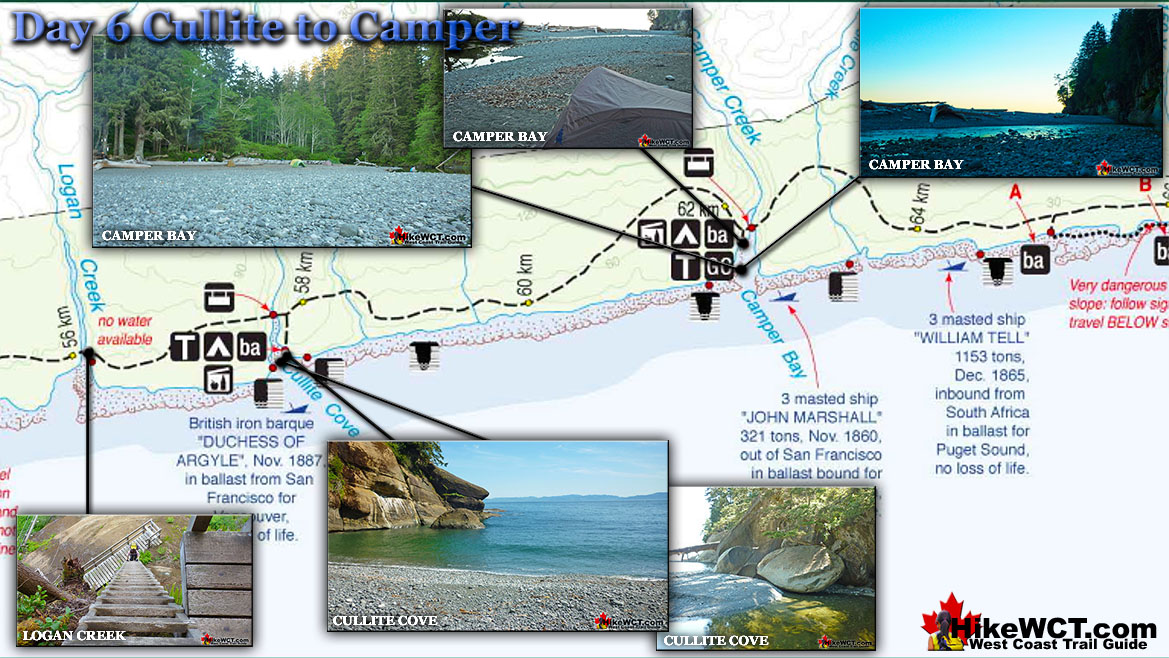![]() Day 5 on the West Coast Trail is a stunning, very difficult and tremendously enjoyable day of hiking. Walbran Creek is gorgeous campsite to wake up to. Your tent will open up to a sweeping view of Juan de Fuca Strait, with the ocean just a dozen metres away. Waking up at Walbran is particularly nice as it exhibits so many great features of the West Coast Trail.
Day 5 on the West Coast Trail is a stunning, very difficult and tremendously enjoyable day of hiking. Walbran Creek is gorgeous campsite to wake up to. Your tent will open up to a sweeping view of Juan de Fuca Strait, with the ocean just a dozen metres away. Waking up at Walbran is particularly nice as it exhibits so many great features of the West Coast Trail.
 Walbran Creek is a very scenic campsite
Walbran Creek is a very scenic campsite Interesting beach to explore at Walbran
Interesting beach to explore at Walbran Walbran Creek is nice to swim in
Walbran Creek is nice to swim in Small sea caves across the creek to see
Small sea caves across the creek to see Very hard section of trail, but rewarding
Very hard section of trail, but rewarding The Logan Creek crossing is extraordinary!
The Logan Creek crossing is extraordinary! Cable car crossing to finish your day
Cable car crossing to finish your day Cullite Creek is great to swim in
Cullite Creek is great to swim in Cullite Cove is frequently deserted
Cullite Cove is frequently deserted Brutally challenging section of the WCT
Brutally challenging section of the WCT
Hike the West Coast Trail
![]() Prologue
Prologue ![]() 1: The West Coast Trail
1: The West Coast Trail ![]() 2: When to Hike & Fees
2: When to Hike & Fees ![]() 3: Trailheads
3: Trailheads ![]() 4: Getting There
4: Getting There ![]() 5: Considerations
5: Considerations ![]() 6: Campsites
6: Campsites ![]() 7: Shipwrecks
7: Shipwrecks ![]() 8: Routes
8: Routes ![]() Day 1 Pachena to Darling
Day 1 Pachena to Darling ![]() Day 2 Darling to Tsusiat
Day 2 Darling to Tsusiat ![]() Day 3 Tsusiat to Carmanah
Day 3 Tsusiat to Carmanah ![]() Day 4 Carmanah to Walbran
Day 4 Carmanah to Walbran ![]() Day 5 Walbran to Cullite
Day 5 Walbran to Cullite ![]() Day 6 Cullite to Camper
Day 6 Cullite to Camper ![]() Day 7 Camper to Thrasher
Day 7 Camper to Thrasher ![]() Michigan Creek at 12k
Michigan Creek at 12k ![]() Darling River at 14k
Darling River at 14k ![]() Orange Juice Creek at 15k
Orange Juice Creek at 15k ![]() Tsocowis Creek at 16.5k
Tsocowis Creek at 16.5k ![]() Klanawa River at 23k
Klanawa River at 23k ![]() Tsusiat Falls at 25k
Tsusiat Falls at 25k ![]() Cribs Creek at 42k
Cribs Creek at 42k ![]() Carmanah Creek at 46k
Carmanah Creek at 46k ![]() Bonilla Creek at 48k
Bonilla Creek at 48k ![]() Walbran Creek at 53k
Walbran Creek at 53k ![]() Cullite Cove at 58k
Cullite Cove at 58k ![]() Camper Bay at 62k
Camper Bay at 62k ![]() Thrasher Cove at 70k
Thrasher Cove at 70k
Ever present ocean views, big and wide body of water flowing from the forest, cliffs with sea caves to explore, nice relaxing beach, fun cable car crossing and challenging, yet exhilarating hiking terrain in both directions. The West Coast Trail is so amazing, because it is so difficult. Long ladders, narrow bridges and steep terrain ensure that you don't get bored while hiking. You have to focus on every step or you may sink into mud up to your knees, or slip on a tree root that topples you into the mud. You must be aware of every ladder rung, as some are missing and they are always slippery. It never escapes your mind that one misstep could send you crashing down hard. The kilometre markers on the West Coast Trail indicate that the hiking distance, Walbran Creek to Cullite Cove is 5 kilometres. Normal hiking speed on a nice, flat beach is about 5 kilometres per hour. You will be lucky to cover the distance today at a speed faster than 1 kilometre per hour. The trail is constantly up and down, zig-zagging left and right. All the time through a thick tangled rainforest with sections of trail destroyed by giant, fallen trees from the previous winter. This section of the West Coast Trail used to have you crossing an extraordinarily elaborate network of ladders and a narrow bridge to get you past Logan Creek. Though the creek is an average creek size, the gorge that surrounds it is enormous. In 2021 the Logan Ladders were replaced by a spectacular new suspension bridge.
Logan Ladders Replaced in 2021
Day 5: Walbran Creek to Cullite Cove on the West Coast Trail
![]() Two kilometres of very arduous trail gets you to to yet another extraordinary cable car crossing. Very long, it spans the gorge with Cullite Cove flowing underneath. Almost all West Coast Trail hikers don't bother with the 15 minute hike down the network of ladders that takes you to Cullite Cove. There are two good reasons for this. First the West Coast Trail in both directions is some of the toughest kilometres you will encounter on the entire length. Taking a detour down a bunch of ladders to sightsee when you are exhausted is an easy thing to talk yourself out of. The other reason is the location of campsites. Owing to its location along the West Coast Trail, everyone camps at Camper Bay, just 4 kilometres away. When hiking from the south, hikers always underestimate the difficulty of the trail and overestimate their endurance. Camping after just 4 kilometres of hiking on your second day on the trail barely registers as an option for most. Such a shame. But great for you if you visit or camp at Cullite Cove because it is one of the nicest campsites on the West Coast Trail. If there was ever a section of the trail to take your time and enjoy, it is this stretch.
Two kilometres of very arduous trail gets you to to yet another extraordinary cable car crossing. Very long, it spans the gorge with Cullite Cove flowing underneath. Almost all West Coast Trail hikers don't bother with the 15 minute hike down the network of ladders that takes you to Cullite Cove. There are two good reasons for this. First the West Coast Trail in both directions is some of the toughest kilometres you will encounter on the entire length. Taking a detour down a bunch of ladders to sightsee when you are exhausted is an easy thing to talk yourself out of. The other reason is the location of campsites. Owing to its location along the West Coast Trail, everyone camps at Camper Bay, just 4 kilometres away. When hiking from the south, hikers always underestimate the difficulty of the trail and overestimate their endurance. Camping after just 4 kilometres of hiking on your second day on the trail barely registers as an option for most. Such a shame. But great for you if you visit or camp at Cullite Cove because it is one of the nicest campsites on the West Coast Trail. If there was ever a section of the trail to take your time and enjoy, it is this stretch.
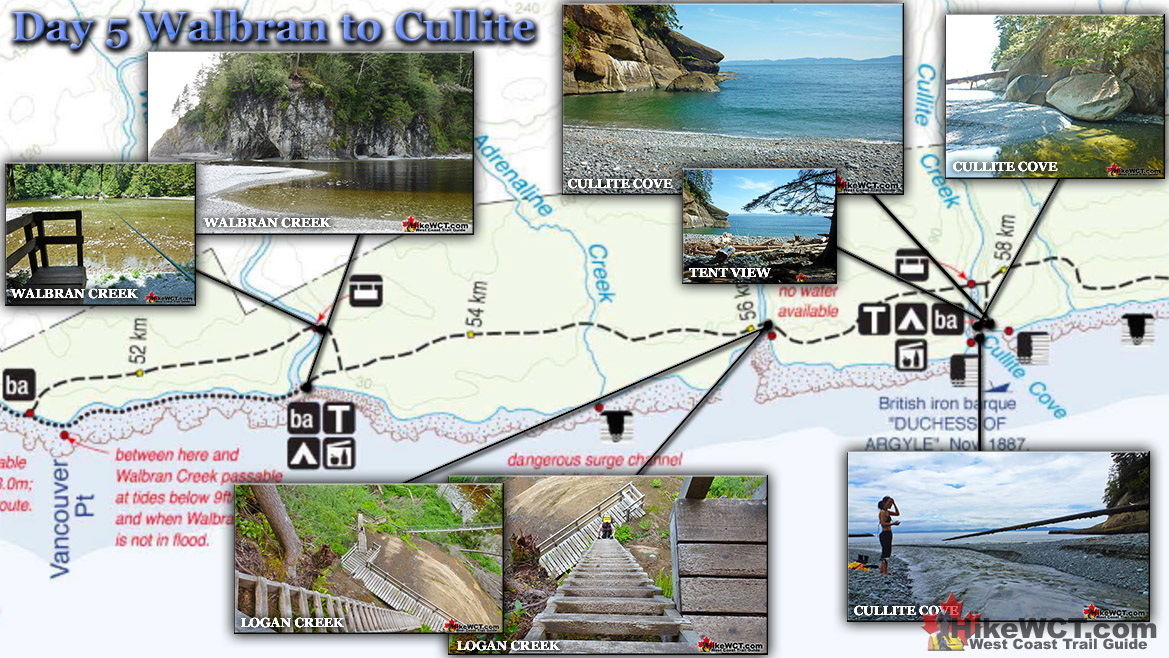
Logan Creek Crossing at 56km
The old Logan Creek network of ladders was a wonderful feature of the West Coast Trail and certainly one of the top highlights of the trail. A narrow 10 inch wide wooden platform bridge in between the ladders on both sides of the chasm made it all the more dramatic. Even the bravest hikers tended to grasp the side cables the entire length. The ladders on either side were equally marvelous. As you look back after climbing the last ladder, you stare in amazement. The memorable moments on the West Coast Trail number in the hundreds, but this moment surely rests near the top of that list. Though the Logan Creek ladder network will be missed, the new bridge built in 2021 is pretty impressive.








Finally Flat Terrain at 57km

More Huge Ladders Down to Cullite Cove
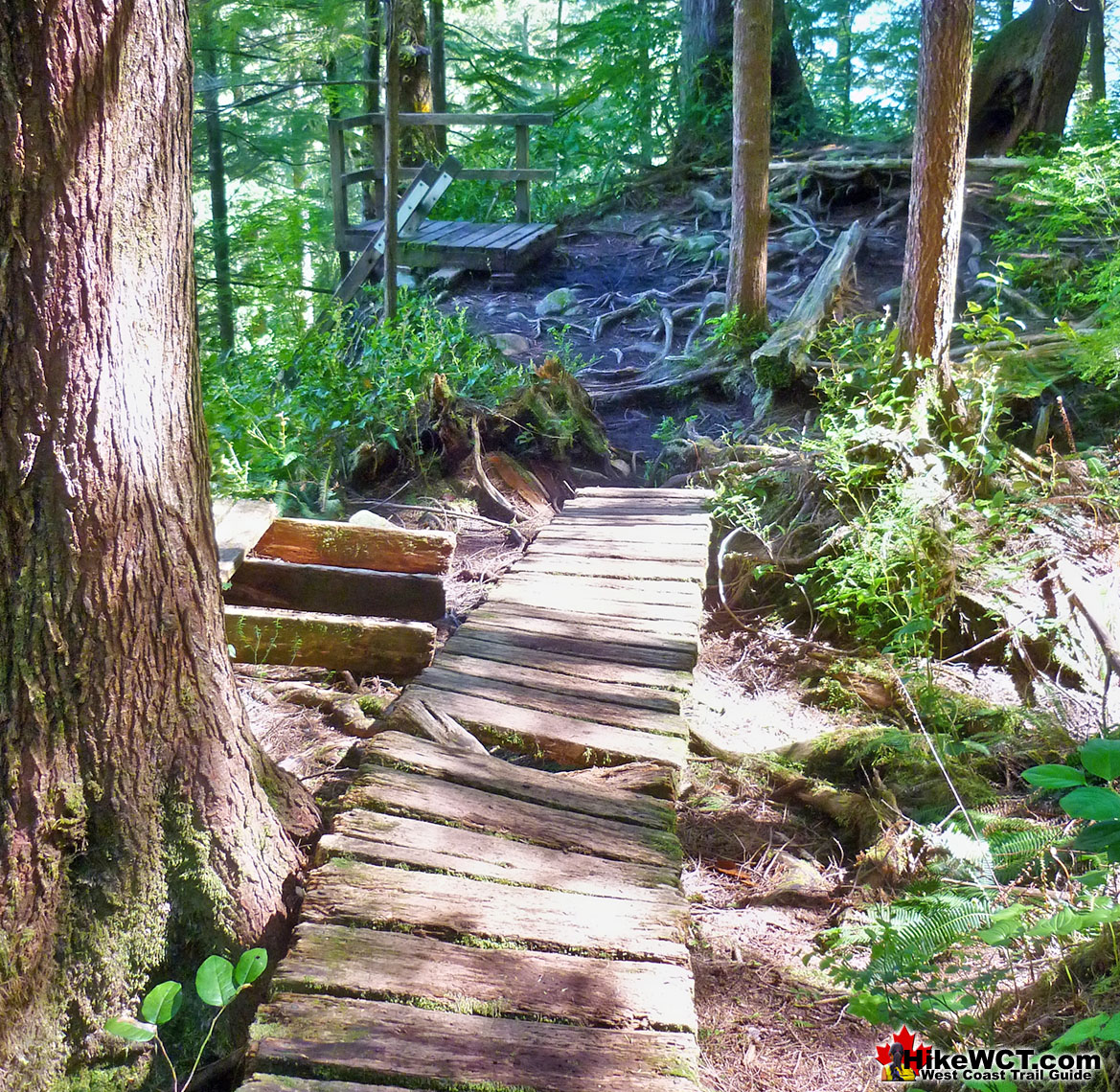

Cullite Cove Campsite at 58km
![]() Cullite Cove is a wonderful campsite on the West Coast Trail at the 58 kilometre mark. One of the nicest campsites you will find on the West Coast Trail. It has everything, a lovely wooded area with clearings for tents and campfires. Stunning views all around. A terrific, rocky beach, beautifully hemmed in by towering cliffs on either side. Cullite Creek pours into the cove, making for a stunning, albeit freezing swim into the surf. Cullite Cove is a close to perfect as a campsite can get. Cullite Creek is beautiful, crystal clear green, big and slow moving into Cullite Cove, a picture perfect beach hemmed in by majestic cliffs on both sides. Just off the beach, several campsites are laid out, hidden in the trees. Your first thought on seeing this site is to want to stay for a week. The campsite here is often very quiet as everybody seems to camp at Camper Bay just 4 kilometres away and doesn't even drop down the short detour off the main trail to Cullite Cove.
Cullite Cove is a wonderful campsite on the West Coast Trail at the 58 kilometre mark. One of the nicest campsites you will find on the West Coast Trail. It has everything, a lovely wooded area with clearings for tents and campfires. Stunning views all around. A terrific, rocky beach, beautifully hemmed in by towering cliffs on either side. Cullite Creek pours into the cove, making for a stunning, albeit freezing swim into the surf. Cullite Cove is a close to perfect as a campsite can get. Cullite Creek is beautiful, crystal clear green, big and slow moving into Cullite Cove, a picture perfect beach hemmed in by majestic cliffs on both sides. Just off the beach, several campsites are laid out, hidden in the trees. Your first thought on seeing this site is to want to stay for a week. The campsite here is often very quiet as everybody seems to camp at Camper Bay just 4 kilometres away and doesn't even drop down the short detour off the main trail to Cullite Cove.



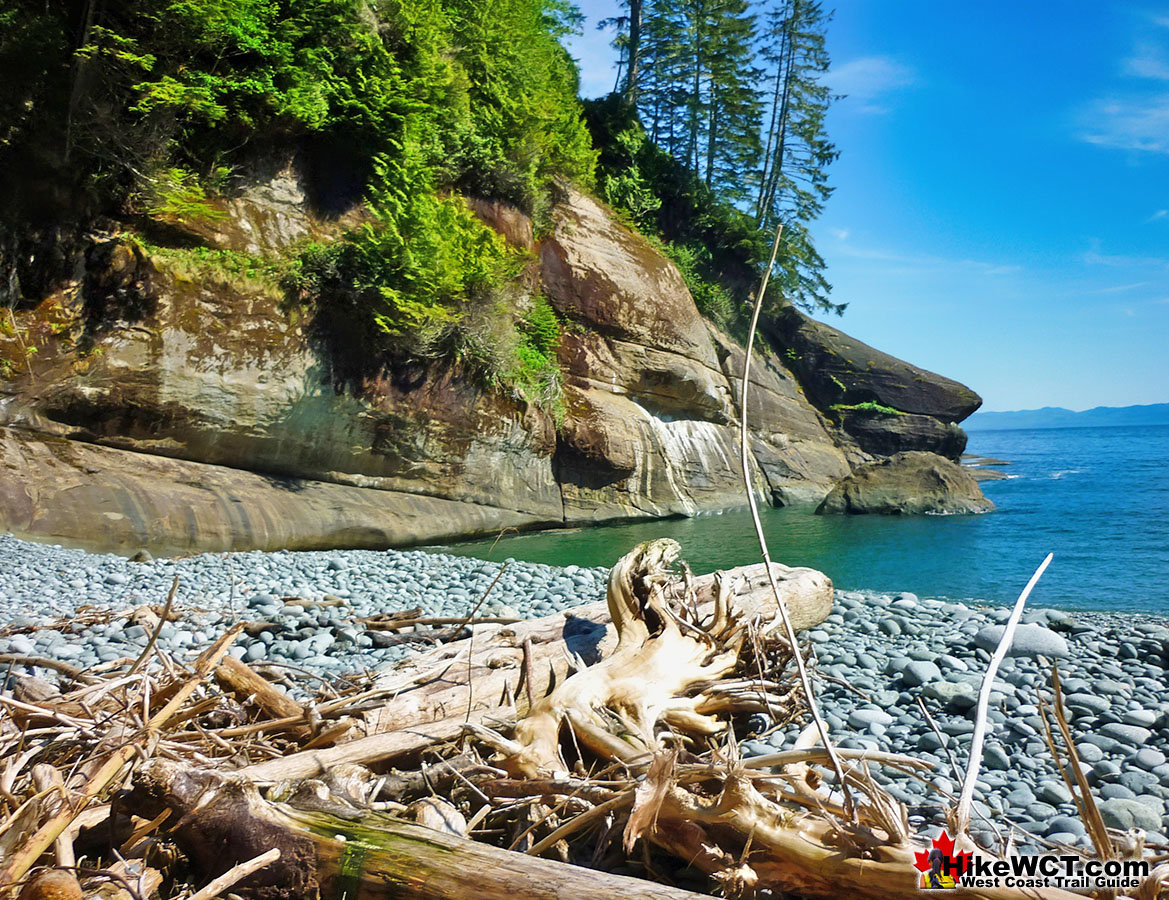




Duchess of Argyle Shipwreck at 58k
![]() The Duchess of Argyle met her end at the mouth of Cullite Cove at the 58 kilometre mark of the West Coast Trail. She was a huge, four masted barque with an iron hull and watertight bulkheads. She was sailing in ballast from San Francisco on October 13th, 1887, bound for Vancouver. She would pick up lumber and sail for Melbourne, Australia. Sailing up the coast from San Francisco, the good weather turned bad on October 16th. For almost two weeks a powerful gale hammered the Duchess of Argyle. When the storm finally let up, Cape Flattery was sighted about 20 miles away. The ship, unable to find wind, floated with the current, inching towards Juan de Fuca Strait. Soon a small tug boat arrived to assist the enormous becalmed ship through the strait. They lowered sails and got the hawser aboard to connect the ships. The captain of the tug quickly realized that his vessel was too small to manage such a huge ship rolling in the seas. Cape Flattery was still about 14 miles distant and concealed by fog much of the time. The Duchess of Argyle wallowed in the current until midnight when a strong eastward gale gripped the ship once more. They sailed for Cape Flattery until the wind died again and on November 1st the fog lifted revealing Cape Flattery just 3 miles away. Suddenly the fog returned again, thicker than ever. They crawled forward slowly hoping for the fog to lift again. The fog didn't let up and at 315pm on November 3rd, breakers were heard...
The Duchess of Argyle met her end at the mouth of Cullite Cove at the 58 kilometre mark of the West Coast Trail. She was a huge, four masted barque with an iron hull and watertight bulkheads. She was sailing in ballast from San Francisco on October 13th, 1887, bound for Vancouver. She would pick up lumber and sail for Melbourne, Australia. Sailing up the coast from San Francisco, the good weather turned bad on October 16th. For almost two weeks a powerful gale hammered the Duchess of Argyle. When the storm finally let up, Cape Flattery was sighted about 20 miles away. The ship, unable to find wind, floated with the current, inching towards Juan de Fuca Strait. Soon a small tug boat arrived to assist the enormous becalmed ship through the strait. They lowered sails and got the hawser aboard to connect the ships. The captain of the tug quickly realized that his vessel was too small to manage such a huge ship rolling in the seas. Cape Flattery was still about 14 miles distant and concealed by fog much of the time. The Duchess of Argyle wallowed in the current until midnight when a strong eastward gale gripped the ship once more. They sailed for Cape Flattery until the wind died again and on November 1st the fog lifted revealing Cape Flattery just 3 miles away. Suddenly the fog returned again, thicker than ever. They crawled forward slowly hoping for the fog to lift again. The fog didn't let up and at 315pm on November 3rd, breakers were heard...
West Coast Trail Day 6: Cullite to Camper
The West Coast Trail by Day
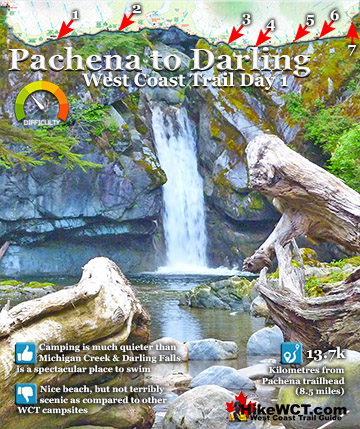


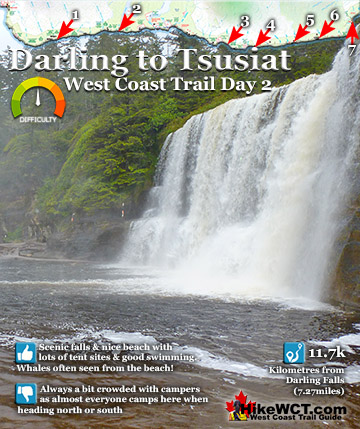
West Coast Trail Campsites

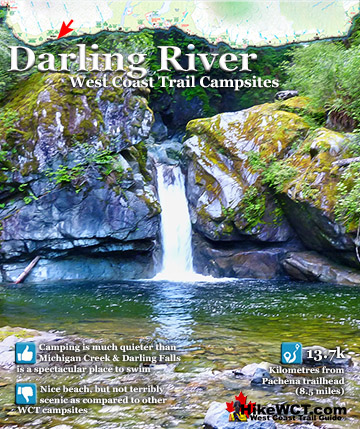

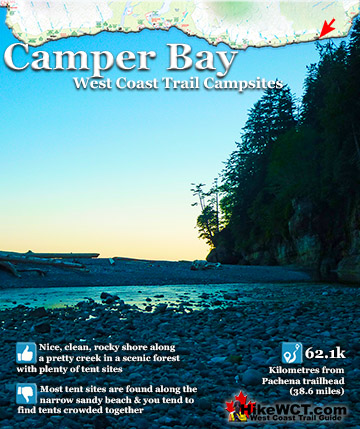
The Valencia Disaster



Explore BC Hiking Destinations!

The West Coast Trail

Victoria Hiking Trails

Clayoquot Hiking Trails

Whistler Hiking Trails

Squamish Hiking Trails

Vancouver Hiking Trails



